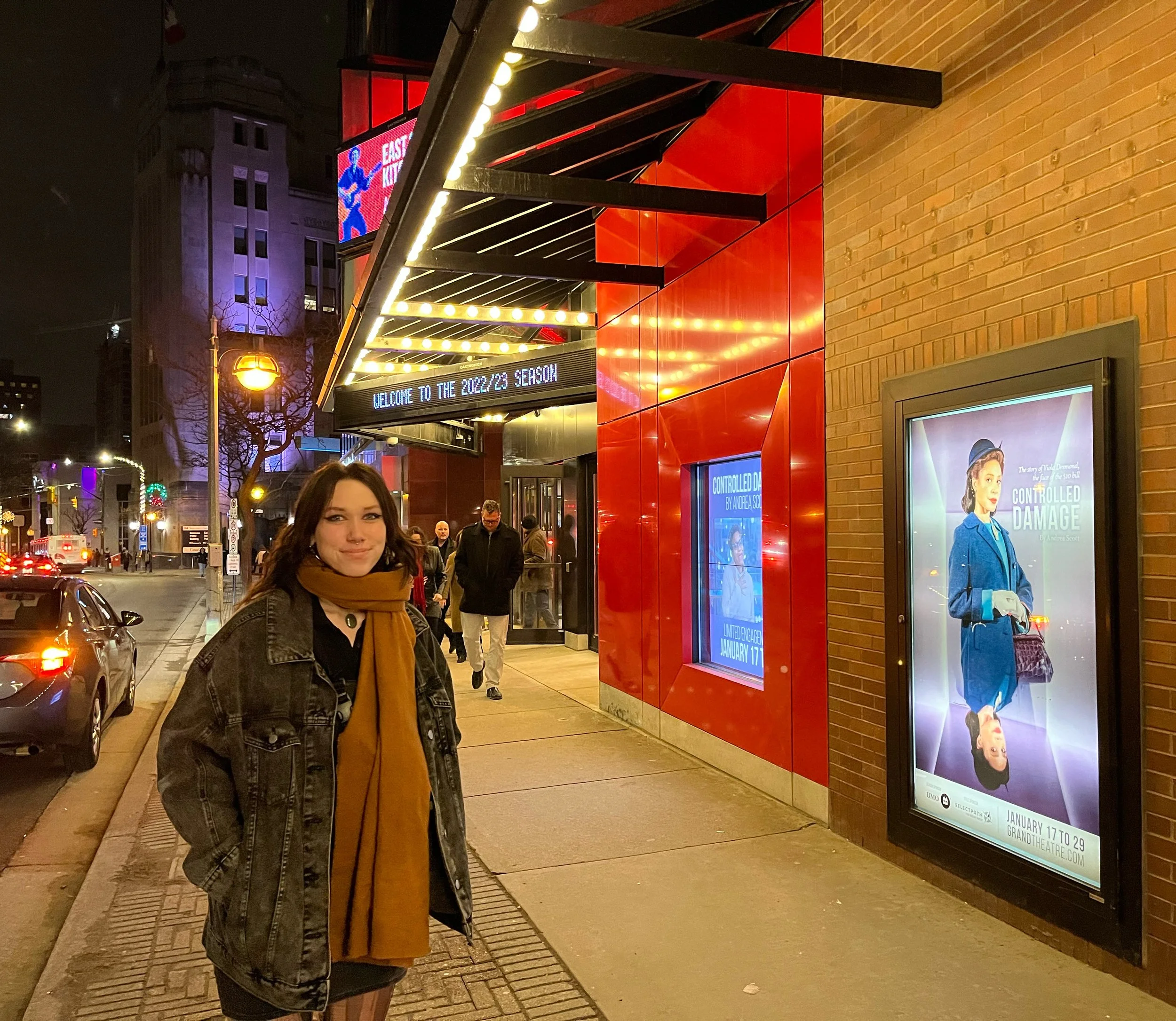Five Reasons to Check Out 'Controlled Damage' at the Grand Theatre
Photo: Avelea Thorne of young & free press outside the Grand Theatre in London, Ontario, following the official opening of Controlled Damage, the play written by Andrea Scott and directed by Ray Hogg.
On November 8, 1946, Viola Desmond went to a movie at the Roseland Theatre in New Glasgow, Nova Scotia. She sat on the main floor – the whites-only section – unaware that she had purchased a ticket for the balcony, where Black audience members were expected to sit. Although she offered to pay the extra cost for a seat on the main floor, she was removed from the theatre, held in jail & charged. This incident of racial discrimination helped to ignite the civil rights movement in Canada. More than seven decades later, in November 2018, the new ten-dollar bill design featuring Desmond went into circulation across Canada, acknowledging the Halifax-based business owner who altered the social history of the country.
In Controlled Damage, playwright Andrea Scott examines the life and times of Viola Desmond, both before and after she was removed from the Roseland Theatre. The play is on now at the Grand Theatre in London, running until January 29th on the Spriet Stage. Members of our team at young & free attended opening night on January 20th, and were impressed by many facets of the production.
Here are our top five reasons to check out the play:
1 / Beck Lloyd is terrific as Viola Desmond, inhabiting this complex character seemingly effortlessly. Her performance feels altogether natural as she charts how Desmond experienced racism, misogyny, and the sort of turbulence faced by anyone who attempts to spark meaningful change. Interestingly, she is present on the stage throughout, even before the play begins and during the intermission, perhaps a nod to the idea of refusing to give back ground that has been gained. This device is effective, prompting audience members to think of Desmond and her impact on Canadian life.
2 / For those who do not know the story of the face of the current ten-dollar bill in Canada, Andrea Scott has done an excellent job of delivering a compact history lesson through the play. Many teachers have used the currency design as a jumping-off point to introduce the story to students, but this does not mean that adults have taken the time to get to know the story. Controlled Damage conveys the information memorably, placing Desmond in the culture of early-to-mid twentieth-century Canada.
3 / There are many references to East Coast history and culture throughout the play, including the presence of Dominique LeBlanc as the fiddler, adding a bit of music to the proceedings. The sound is never overwhelming and provides interesting subtext, kind of a reminder of the more superficial way of thinking of Nova Scotia, all fiddle music and kitchen parties. Having this as a counterpoint to the far more serious story of Viola Desmond is compelling – are we being asked to recognize how willing we are to ignore instances of discrimination in favour of a cheerier version of Canada? One could be reminded of how Gord Downie implored Canadians to look beyond hockey and donuts and face the terrible legacy of residential schools.
4 / The whole cast is strong, but Starr Domingue really shines as Rosy, a friend to Viola Desmond. She brings a warm energy to the stage throughout. Grand Theatre audiences will remember Domingue from her turns in Room and Oil and Water, and she has performed at the Stratford Festival in Little Shop of Horrors and Billy Elliott.
5 / One of the most intriguing aspects of Controlled Damage is the set design and staging. Neon bars frame the proceedings, providing the shape of the classroom in which Viola Desmond taught, the beauty salon that she owned and operated, and the theatre from which she was removed. The shape of the light continually draws the attention of the audience, and inside the frame is where the action happens. We noted as well that the cast members, who are identified in the program by names such as Man 1, Man 2, and Man 3, and Woman 1, Woman 2, and Woman 3, come into the frame as specific characters and then remain on stage at the margins as observers. Might this be a way of indicating how people can become bystanders if they refuse to act? Details like this in the play give audience members plenty to contemplate.
Check out Controlled Damage at the Grand – find more information & ticket details here.






